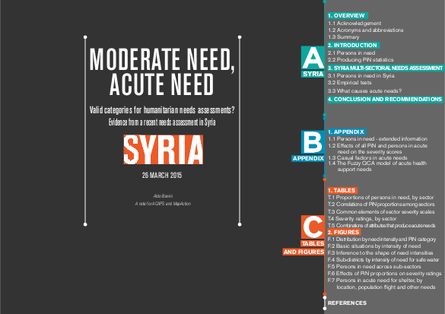
Needs assessments in emergencies seek to establish, among other elements of the situation, the number of persons in need. “Persons in need” is a broad and fuzzy concept; counts, proportions and other measures capturing how many are in need, and how intensely, are necessarily imprecise. Some sectors achieve greater precision by applying specific standards, such as in malnutrition surveys. However, such methods are not feasible in types of assessments that depend largely on local key informant estimates.
Greater depth, if not outright precision, may be achieved in other ways. Categories can be refined. Instead of just the binary “persons in need” / “not in need”, needs may be graded. Several recent needs assessments in Syria have done so by distinguishing between “persons in moderate need” and “persons in acute need”. This note is about this kind of refinement in persons-in-needs (PiN) estimates in the most recent assessment. The Syria Multi-Sectoral Needs Assessment (MSNA), released in October 2014, provides PiN estimates for 126 of the 270 sub-districts of the country. Persons in moderate and in acute need have been estimated separately for five sectors - food security, shelter, non-food items (NFI), health and safe water.